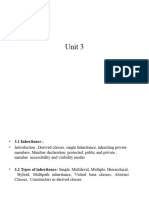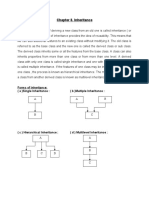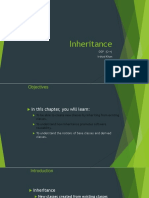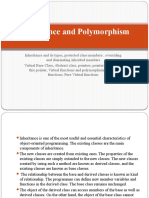0 ratings0% found this document useful (0 votes)
12 views28 pagesC
VTU text book
Uploaded by
skydrake34Copyright
© © All Rights Reserved
We take content rights seriously. If you suspect this is your content, claim it here.
Available Formats
Download as PDF or read online on Scribd
0 ratings0% found this document useful (0 votes)
12 views28 pagesC
VTU text book
Uploaded by
skydrake34Copyright
© © All Rights Reserved
We take content rights seriously. If you suspect this is your content, claim it here.
Available Formats
Download as PDF or read online on Scribd
You are on page 1/ 28
Inheritance:
| Extending Classes
YV¥VYV¥Y¥Y¥YYY¥Y¥YYYYY ¥
Key Concepts
Reusability
Inheritance
‘Single inheritance
Multiple inhe
Multilevel
°
tance
Hybrid inh ance
Hierarchical inheritance:
Defining a derived class
Tnheritiing private members
Virtual base class
Direct base class
Indirect base class
Abstract class
Defining derived class constructors
Nesting of classes
8.1 Introduction
Reusability is yet another important
feature of OOP. It is always nice if we could
reuse something that already exists rather
than trying to create the same all over
again. It would not only save time and
money but also reduce frustration and
inerease reliability. For instance, the reuse
of a class that has already been tested,
debugged and used many times can save
us the effort of developing and testing the
same again.
Fortunately, C++ strongly supports the
concept of reusability. The C++ elasses ean
be reused in several ways. Once a class has
been written and tested, it can be adapted
by other programmers to suit their
requirements, This is basically done by
creating new classes, reusing the properties
of the existing ones. The mechanism of
deriving a new class from an old one is
called inheritance (or derivation). The old
class is referred to as the base class and
the new one is called the derived class or
subclass.
Copyrighted material
2020—_—_——————_ Object-Oriented Programming with C++
The derived class inherits some or all of the traits from the base class. A class can also
inherit properties from more than one class or from more than one level. A derived class
with only one base class, is called single inheritance and one with several base classes is
called multiple inheritance. On the other hand, the traits of one class may be inherited by
more than one class, This process is known as hierarchical inheritance. The mechanism of
deriving a class from another ‘derived class’ is known as multilevel inheritance. Figure 8.1
shows various forms of inheritance that could be used for writing extensible programs. The
direction of arrow indicates the direction of inheritance. (Some authors show the arrow in
opposite direction meaning “inherited from".}
\] |
cy] B Le D
(0) Api terance fase teens
r ea
1
+
B 8 {e
a 3
tn maven pews Saco
Fig. 8:1. <> Forms of irihevitance
l Defining Derived Classes
A derived class can be defined by specifying its relationship with the base class in addition
to its own details. 'The general form of defining a derived class is:
Copyrighted material
Inheritance; Extending Classes. ———@ 203.
class derived-class-name : vistbility-mode base-class-name
Al
/| menbers of derived class
The colon indicates that the derived-class-name is derived from the base-class-name. The
visibility-mode is optional and, if present, may be either private or public. The default
visibility-mode is private. Visibility mode specifies whether the features of the base class
are privately derived or publicly derived.
Exampk
class ABC: private KYZ // private derivation
{
members of ABC
class ABC: public XYZ // public derivation
members of ABC
h
class ABC: XYZ // private derivotion by default
‘ members of ABC
h
When a base class is privately inherited by a derived class, ‘public members’ of the base
class become ‘private members’ of the derived class and therefore the public members of the
‘base class can only be accessed by the member functions of the derived class. They are
inaccessible to the objects of the derived class. Remember, a public member of a class can be
accessed by its own objects using the dot operator. ‘The result is that no-member of the base
class is accessible to the objects of the derived class.
On the other hand, when the base class is publicly inherited, ‘public members’ of the
base class become ‘public members’ of the derived class and therefore they are accessible to
the objects of the derived class. In both the cases, the private members are not inherited and
therefore, the private members of a base class will never become the members of its derived
class.
In inheritance, some of the base class data elements and member funetions are ‘inherited’
into the derived class. We can add our own data and member functions and thus extend the
Copyrighted material
204.0 —_ Object-Oriented Programming with C++
functionality of the base class. Inheritance, when used to modify and extend the capabilities
of the existing classes, becomes a very powerful tool for incremental program development.
I Single Inheritance
Let us consider a simple example to illustrate inheritance, Program 8.1 shows a base class
B and a derived class D. The class B contains one private data member, one public data
member, and three public member functions. The class D contains one private data member
and two public member functions.
pial te bes
finclude
using namespace std;
class 8
{
int-ay // private; not inheritabie
public
int by f{ publics ready for inheritance
void get_db(};
int get a(void);
void show_a(void);
i
class D; public B // public derivation
{
int c;
public,
woid mul (void);
void display(void);
ie
Mfr
void B i: get_ab(void)
{
a= 5 b= 10;
}
int 6 :: get_a()
{
return a3
I
void B13 show_a()
{
(Contd)
Copyrighted material
Inheritance: Extending Classes ——————® 205
cout << "a=" << a << "\n";
}
void D sz mul()
{
c= b* get ats
)
void 0 :: display()
{
cout << "a= * << get_a() <¢ "\n";
cout <¢ "hs * ce hee “\nty
cout << "c= * << ¢ << *\n\n
d.get_ab();
d.mul();
d.show_a();
d.display()s
d.b = 20;
d.mul()5
d.display();
return O;
Given below is the output of Program 8.1:
a-5
a=5
b= 10
c= 50
aes
b= 20
c= 100
The class D is a public derivation of the base class B. Therefore, D inherits all the public
members of B and retains their visibility, Thus a public member of the base class B is also
a public member of the derived class D. The private members of B cannot be inherited
Copyrighted material
206e—___—_——_ Object-Oriented Programming with C++
by D. The class D, in effect, will have more members than what it contains at the time of
declaration as shown in Fig. 8.2.
mull)
dispiay()
Fig.82 43 Adding more members to a class (by public derivation)
‘The program illustrates that the abjects of class D have access to all the public members
of B. Let us have a look at the functions show_a() and mul();
void show_a()
cout << "a= "<> a >> b
y
int B :: get_a()
{
return a;
}
void B :: show a()
{
cout << "gs * ce a xe *\nty
void D :: mul() (ees
get_ab()i
5 b * get_a()s // ‘a’ cannot be used directly?!)
Devas ¥ enh ed
ie otk sie ee:
void D :: display() f =
show_a() J/ outputs value of ‘a!
cout << "b= "ce b Access mechanism in classes
Ie. 5 Multilevel Inheritance
It is not uncommon that a elass is derived from another derived class as shown in Fig. 8.7.
‘The class A serves as a base class for the derived class B, which in turn serves as a base
class for the derived class C. The class B is known as intermediate base class since it provides
a link for the inheritance between A and C. The chain ABC is known as inheritance path.
Copyrighted material
214 @———_ ject Oriented Programming with C++
Allusers
derived class private | ‘own member functions
member and friendly functions
funetions and classes
protected
Fig. 86 2A simple view of access control to the members of a class
Base class [A] Grandtather
Intermediate
Sarat [oe | rene
Derived cass |G | Child
Fig.8.7 <> Multilevel inheritance
” A derived class with multilevel inheritance is declared as follows:
ahs Jf Bose class
public A [....013 // 8 dertved from A
public B {..eeeds Jf C derived from &
class Af
class
class
This process can be extended to any number of levels.
‘Let us consider a simple example. Assume that the test results of a batch of students are
stored in three different classes. Class student stores the roll-number, class test stores the
marks obtained in two subjects and class result contains the total marks obtained in the
test. The class result can inherit the details of the marks obtained in the test and the roll-
number of students through multilevel inheritance. Example:
Copyrighted material
Inheritance: Extending Classes. ———————— 215
class student
1
protected:
int rol]_numbers
public:
void get_nunber(int);
void put_nunber (void) ;
void student :: get_number(int a) .
{
© rell_number * 33
'
void student :: put_number()
{
cout << "Roll Number: " << roll_number << "\n
'
class test : public student // First tevel derivation
{
protected:
float subl;
Float sub2s
public:
void get_marks(float, float);
void put_marks (void) ;
hi
void test :: get_marks(float x, float y)
{
subl = x;
sub2 = yz
1
void test =: put_marks()
{
cout << “Marks im SUBL = " << sub] << "\n*;
cout << "Marks in SUBZ = " << sub? << "\n";
I
class result : public test fj Second level derivation
{
float total; // private by defouit
public:
void display(vo
}
The class result, after inheritance from ‘grandfather’ through ‘father’, would contain the
following members:
Copyrighted material
216 @—$<$@—___—__—— Object-Oriented Programming with C++
private:
float total; Af onn member
protected:
int rol]_numbers // inherited from student via test
float subl; if inherited from test
float sub2; // inhertted from test
publics
void get_number(int); // from student vio test
void put_number(void) ; jj from student vio test
void get_marks(float, float); if from test
void put_marks (void); Af from test
_void display(void) ; Jf own member
The inherited functions put_number() and put_marks() can be used in the definition
of display() function:
void result i: display(void)
‘total = subl + sub2;
put_number() 5
put_marks();
cout << "Total = " << total << "\n";
}
Here is a simple main() program:
int main()
result studentl; /} Student1 created
student1.get_number(111);
Studentl.get_marks(75.0, 59.5);
student.display()s
return 0;
}
This will display the result of student. The complete program is shown in Program 8.3.
ce
ate aE Las
#include Multiple inheritance
Copyrighted material
Inheritance: Extending Classes. 219
The syntax of 'a derived class with multiple base classes is as follows:
class D: visibility B-1, visibility B-2 ...
(
where, visibility may be either public or private. The base classes are separated by commas.
Example:
class P : public M, public N
(
public:
void display(void);
h
Classes M and N have been specified as follows:
class M
{
protected:
int m;
public:
void get_m(int):
hs
void Mz: get_m(int x)
{
}
class N
{
protected:
int
public:
void get_n(int);
mx
hs
void N :: get_n(int y)
{
Copyrighted material
220@———- Object-Oriented Programming with C++
n= ye
+
‘The derived class P, as declared above, would, in effect, contain all the members of M and
N in addition to its own members as shown below:
class P
{ Ee
protected:
it Uf from
t Vi from
public:
void get_m(int); LW from #
void get_n(int); MW from
void display(votd): Lown member
h
‘The member function display() can be defined as follows:
void P :: display(void)
{
cout << "m= " << m << "\n";
cout << "n= "<< n << "\n";
cout << "mn =" << m*n << "\n"s
The main() function which provides the user-interface may be written as follows:
main()
{
Pp;
p.get_m(10);
peget_n(20);
p.display();,
}
Program 8.4 shows the entire code illustrating how all the three classes are implemented
in multiple inheritance mode.
Copyrighted material
Inheritance: Extending Classes
CRs eas Us ae ad
#include
using namespace std;
class M
{
protected:
int m
public:
void get_m(int);
hs
class N
{
protected:
int m3
public:
void get_n(int);
i
class P : public M, public N
{
publict
void display (void);
hi
void M
{
1
: get_m(int x)
mex
void N :: get_n(int y)
{ :
}
void P
{
ney;
+ display(votd)
cout << "m= "<< mc "\n";
cout << "n= * <¢n << "\n
cout << “mn =" << mtn <<
int main()
(Contd)
Copyrighted material
222 @ ject Oriented Programming with C++
Pp
p.get_m(10) ;
p.get_n(20) 5
pedisplay() 5
return 0;
ROGRAM &.4
‘The output of Program 8.4 would be:
m= 10
n= 20
mn = 200
Ambiguity Resolution in Inheritance
Oceasionally, we may face a problem in using the multiple inheritance, when a function
with the same name appears in more than one base class. Consider the following two classes,
class M
public:
void display(votd)
{
cout << "Class M\n";
i
class N
{
public:
void display (void)
{
cout << "Class Nin";
)
VM
Which display() function is used by the derived class when we inherit these two classes?
We can solve this problem by defining a named instance within the derived class, using.the
class resolution operator with the function as shown below:
class P : public M, public N
Copyrighted material
Inheritance: Extending Classes. —————® 223
(
public:
void display (void) J/ overrides display() of M and N
{
}
M ss display();
)s
‘We can now use the derived class as follows:
int main()
{
Pps
; p.display();
Ambiguity may also arise in single inheritance applications. For instance, consider the
following situation:
class A
{
public:
fo display()
cout << "An";
}
hs
class 8 : public A
{
public:
void display()
{
}
cout << "B\n";
hs
In this case, the function in the derived class overrides the inherited function and,
therefore, a simple call to display() by B type object will invoke function defined in B only.
However, we may invoke the function defined in A by using the scope resolution operator to
specify the class.
Example:
int main()
{
Copyrighted material
2240e————_———_. Object-Oriented Programming with C++
// derived class object
// invokes display() in B
ff invokes display() in A
Jf invokes display() in B
return Os
!
This will produce the following output:
8
A
B
[s.7 Hierarchical Inheritance
‘We have discussed so far how inheritance can be used to modify a class when it did not
satisfy the requirements of a particular problem on hand. Additional members are added
through inheritance to extend the capabilities of a class. Another interesting application of
inheritance is to use it as a support to the hierarchical design of a program. Many
programming problems can be cast into a hierarchy where certain features of one level are
shared by many others below that level.
‘As an example, Fig. 8.9 shows a hierarchical classification of students in a university.
Another example could be the classification of accounts in a commercial bank as shown in
Fig. 8.10. All the students have certain things in common and, similarly, all the accounts
possess certain common features.
Medical
Mech, Elec. | civil
Copyrighted material
Inheritance: Extending Classes. 225,
Account
Savings account
Fig. 8:10 3 Classification of hank rccounts
In C++, such problems can be easily converted into class hierarchies. The base class will
include all the features that are common to the subclasses. A subclass can be constructed by
inheriting the properties of the base class, «A subclass can serve as a base class for the lower
level classes and so on.
8.8 Hybrid Inheritance
There could be situations
where we need to apply two
or more types of inheritance
to design a program. For
instance, consider the case of
processing the student
results discussed in See. 8.5.
Assume that we have to give
weightage for sparts before
finalising the results. The
weightage for sports is stored
in a separate class called
sports. The new inheritance
relationship between the
Various classes would be as 8.1L Multilevel, mult inheritrce |
shown in Fig. 8.11. peraees es
Copyrighted material
226 @—_—- Object-Oriented Programming with C++
‘The sports class might look like:
class sports
{
protected:
float scores
public:
void get_score(flo:
void put_score(voi
1
The result will have both the multilevel and multiple inheritances and its declaration
would be as follows:
Class result ; public test, public sports
{
hi
Where test itself is a derived class from student. That is
"class test + public student
h ~
Program 8.5 illustrates the implementation of both multilevel and multiple inheritance.
#include
using namespace std; :
class student
protected:
int rol1_numb
public:
void get_number(int a) .
{
rol]_number = a;
(Contd)
CG opy righted material
Inheritance: Extending Classes. ————® 227
}
void put_number(void)
{
cout. << "Roll No; " << roll_number << "\n"
jass test : public student
protected:
float partl, part2;
public: :
void get_marks(float x, float y) :
{
part] = x; part2 = yz
1
void put_marks (void)
{
cout << "Marks obtained: " <<."\n"
<< "Partl = "ce part! << "\n"
<< “Part? = * << part? << "\nl;
Ms
class sports
{
protected:
float score;
public:
void get_score(float s)
{
score = Si
!
void put_score(void)
cout << "Sports wt: " << score << "\n\n'
i
class result ¢ public test, public sports fea
{
float total;
public:
void display (void) ;
Copyrighted material
228 @—_£_——_————— Object-Oriented Programming with C++
hk
void result :: display(void)
total = partl + part2 + score;
put_number();
put_marks();
put_score();
cout << "Total Score: " << total << "\n"j
}
int main()
result student_1;
student_1,get_number(1234);
student 1.get marks (27.5, 33.0);
Student_l.get_score(6.0);
student_l.display();
return 0;
ream
Here is the output of Program 8.5:
Rol] No: 1234
Marks obtained:
Partl = 27.5
Part2 © 33
Sports wt: 6
Total Score: 66.5
[s2 Virtual Base Classes
We have just discussed a situation which would require the use of both the multiple and
multilevel inheritance. Consider a situation where all the three kinds of inheritance, namely,
multilevel, multiple and hierarchical inheritance, are involved, This is illustrated in
Fig. 8.12. The ‘child’ has two direct base classes ‘parent!’ and ‘parent2' which themselves
have a common base class ‘grandparent’. The ‘child’ inherits the traits of ‘grandparent’ via
two separate paths. It can also inherit directly as shown by the broken line. The ‘grandparent’
is sometimes referred to as indirect base class.
Copyrighted material
You might also like
- Chapter 3 - Inheritance - Extending Classes1No ratings yetChapter 3 - Inheritance - Extending Classes113 pages
- COMPBBE39312rObjrBh - OOP UNIT 2 InheritanceNo ratings yetCOMPBBE39312rObjrBh - OOP UNIT 2 Inheritance46 pages
- BCA 3.3 Non Linear Data Structure Using C++No ratings yetBCA 3.3 Non Linear Data Structure Using C++25 pages
- INHERITANCE - Object-Oriented ProgrammingNo ratings yetINHERITANCE - Object-Oriented Programming14 pages

























































